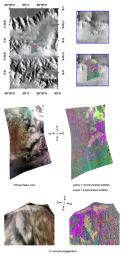This image of sulfate-containing deposits in Tithonium Chasma was taken by the Compact Reconnaissance Imaging Spectrometer for Mars (CRISM) at 1538 UTC (11:38 a.m. EDT) on August 31, 2007 near 5.22 degrees south latitude, 270.48 degrees east longitude. CRISM's image was taken in 544 colors covering 0.36-3.92 micrometers, and shows features as small as 40 meters (132 feet) across. The region covered is just over 10 kilometers (6.2 miles) wide at its narrowest point.
Tithonium Chasma lies at the western end of the Valles Marineris canyon system. It extends approximately east-west for roughly 810 kilometers (503 miles), varies in width from approximately 10 to 110 kilometers (6 to 68 miles), and cuts into the Martian surface to a maximum depth of roughly 6 kilometers (4 miles).
The top panel in the montage above shows the location of the CRISM image on a mosaic taken by the Mars Odyssey spacecraft's Thermal Emission Imaging System (THEMIS). The CRISM data covers an area centered on a ridge of erosion-resistant rock.
The center left image, an infrared false color image, reveals banded, light-colored material draped on the ridge. The center right image unveils the mineralogical composition of the area, with yellow representing monohydrated sulfates (sulfates with one water molecule incorporated into each molecule of the mineral) and purple polyhydrated sulfates (sulfates with multiple waters per mineral molecule).
The lower two images are renderings of data draped over topography with 7 times vertical exaggeration. These images provide a view of the topography and reveal how the sulfate deposits both cover and flank the ridge. Brighter, monohydrated sulfate (yellow) deposits revealed in the lower right image lies along the ridge's northwest side and fall off into a small valley or depression, while darker polyhydrated sulfates (purple) lie along the ridge's northeast flank. A deposit of both mono- and polyhydrated sulfates spanning the ridge near its crest also appears to be coarsely banded.
CRISM is one of six science instruments on NASA's Mars Reconnaissance Orbiter. Led by The Johns Hopkins University Applied Physics Laboratory, Laurel, Md., the CRISM team includes expertise from universities, government agencies and small businesses in the United States and abroad. NASA's Jet Propulsion Laboratory, a division of the California Institute of Technology in Pasadena, manages the Mars Reconnaissance Orbiter and the Mars Science Laboratory for NASA's Science Mission Directorate, Washington. Lockheed Martin Space Systems, Denver, built the orbiter.

 Planetary Data System
Planetary Data System












